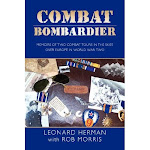
The following article was in Wednesday's Idaho Falls Post Register. It mentions my late friend Lee Kessler, who was also at Stalag 17-B near Krems, Austria after being shot down in WWII.
It's a small world. I plan to get in touch with Mr. Hess in the near future.
"Two men who met at the Idaho State Veterans Home were also prisoners of war at Stalag 17-B during World War II.
BOISE -- All veterans share a bond, but the one Mel Schwasinger and Francis Hess discovered while residents of the Idaho State Veterans Home was stunning.
The two 90-year-olds wouldn't seem to have much in common. Hess is a native of Philadelphia; Schwasinger grew up on a farm near Nampa. Schwasinger spent most of his working years as a sugar beet farmer; Hess was a career military man.
That the two would end up together at the Veterans Home in Boise was an unlikely coincidence. But the other thing they had in common was beyond unlikely.
Both were prisoners of war at Stalag 17-B, one of the most notorious Nazi prison camps in World War II and the inspiration for "Stalag 17," the Academy Award-winning film starring William Holden.
"I don't even want think about the odds of that," Veterans Home Volunteer Coordinator Phil Hawkins said.
The men discovered their shared history during a conversation earlier this year, while both were residents of the veterans home; Schwasinger has since moved to a private care facility.
Half a century fell away as they recalled the deprivations of POW-camp life in Nazi-occupied Austria, where the two never met.
"You got a shower every six months whether you needed it or not," Schwasinger said.
Hess lamented the scarcity of the "little coal briquettes that they gave us for heat. There were never enough, and it was always cold. Guys would rub each other's backs to try to stay warm."
The prisoners were so hungry that "we stole the potato peelings the Germans left from preparing their food," Schwasinger said. "What they gave us wasn't fit for pigs."
Schwasinger weighed 165 pounds when he was imprisoned and 105 when he was liberated 17 months later.
Hess was there even longer. His wife, Mary, said her husband became so accustomed to sleeping on a slab of wood that "when he got home, his mother found him asleep on the floor under the bed. It took him a while before he could sleep in a real bed again."
An Army Air Corps radio operator and gunner on a B-17 bomber, Hess was shot down over France on Dec. 20, 1942. He almost came out of his parachute, which snagged on his nose on the way down.
"I'd have died if I hadn't had a big nose," he said. "A Frenchman found me and stopped the bleeding. Then the Germans came."
Schwasinger's B-17, the "Luscious Duchess," was shot down a little over a year later. A turret gunner, he has said he shot down at least 10 German fighter planes that day and possibly as many as 18. His collection of WWII medals includes the Distinguished Flying Cross.
Both men were freed during the waning weeks of the war in 1945, when the camp was emptied and the Germans fled Austria in advance of invading Russian troops.
"They marched us 210 miles to the German border, where we had troops," Hess said. "That's when we saw what they had done to the Jews.
"A friend of mine did a drawing of something he saw along the way, a dead man's hand with a picture of his wife and children. A butterfly had landed on his hand."
 I took these photos of Lee when visiting him in Canton, Ohio. RM
I took these photos of Lee when visiting him in Canton, Ohio. RMThat drawing, by his friend Lee Kessler, has been displayed in Holocaust museums around the world.

Hess's WWII experience only increased his desire to serve his country in the military. He spent 25 years in the Air Force, retired as a master sergeant and worked as a civilian for the Navy, testing catapults for aircraft carriers. He moved to Idaho in the mid-1980s, following his son, Francis Hess Jr., who was serving at Mountain Home Air Force Base.
Hess and his late wife had six sons, five of whom served in the military. The youngest followed his father's career path by retiring as a master sergeant. Their only daughter married a military man, and his current wife, Mary, was a Navy WAVE during WWII.
"Serving in the war made everyone more patriotic," he said. "You couldn't see what we did and not be patriotic. It taught me that there's no place else in the world like the U.S."
Schwasinger feels the same way. Though he remembers the sky on the day he was shot down as being filled with nothing but parachutes and burning airplanes, he said he'd do it all again.
"It was scary, but necessary," he said. "There was no question that we had to do what we did."
"It was scary, but necessary," he said. "There was no question that we had to do what we did."






No comments:
Post a Comment